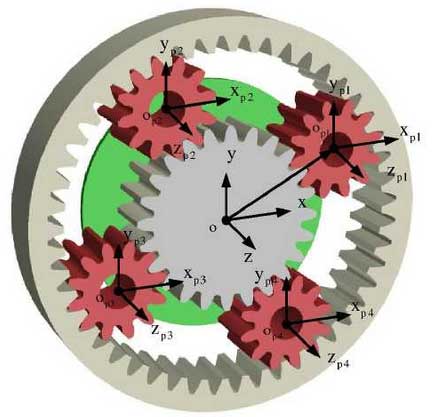This study investigates the degradation mechanism of time-varying mesh stiffness (TVMS) in wind turbine planetary gear systems under tooth root crack faults. A nonlinear dynamics framework combined with numerical analysis is developed to quantify stiffness variations caused by non-penetrating and penetrating crack configurations in helical planetary gears.

1. Crack Propagation Modeling
Two distinct crack types are modeled for planet gear analysis:
Penetrating Cracks: Parabolic depth profile spanning entire tooth width
$$y = a(x – h)^2 + k$$
where \(a\) defines curvature, \(h\) is vertex position, and \(k\) determines maximum depth.
Non-Penetrating Cracks: Dual parabolic functions governing depth and width
$$\text{Depth: } z = b(x – m)^2 + n$$
$$\text{Width: } y = c(z – p)^2 + q$$
Parameters \(b,c\) control spatial propagation rates in respective directions.
2. Crack Severity Metrics
Crack progression is quantified through dimensional ratios:
$$\text{Depth ratio} = \frac{\text{Actual depth}}{\text{Maximum possible depth}} \times 100\%$$
$$\text{Width ratio} = \frac{\text{Crack span}}{\text{Tooth width}} \times 100\%$$
| Crack Type | Depth Ratio | Width Ratio | Model Variants |
|---|---|---|---|
| Penetrating | 10-80% | 100% | 4 |
| Non-Penetrating | 10-80% | 25-100% | 16 |
3. Mesh Stiffness Calculation
The torsional stiffness formulation for planet gear meshing:
$$K_t = \frac{T}{\Delta\theta}$$
where \(T = 1.65 \times 10^5\;N\cdot mm\) represents operational torque. Normal mesh stiffness derives from:
$$K = \frac{K_t}{r_b^2}$$
with base circle radius \(r_b = \frac{m_n z}{2\cos\beta}\) for helical gears (\(m_n\): normal module, \(z\): teeth count, \(\beta\): helix angle).
4. Stiffness Degradation Analysis
Stiffness degradation rate quantifies crack impacts:
$$H = \frac{K_p – K_c}{K_p} \times 100\%$$
where \(K_p\) = healthy stiffness, \(K_c\) = cracked stiffness.
| Crack Depth | Penetrating (H%) | Non-Penetrating (H%) |
|---|---|---|
| 10% | 2.93 | 7.78 |
| 20% | 6.67 | 11.25 |
| 50% | 13.64 | 15.27 |
| 80% | 24.22 | 17.69 |
5. Dynamic Mesh Behavior
Planet gear mesh stiffness exhibits characteristic fluctuations:
$$K_{TVMS} = \begin{cases}
K_1 & \text{Single-tooth contact} \\
K_1 + K_2 & \text{Double-tooth contact}
\end{cases}$$
where contact ratio \(\varepsilon_\beta = 1.86\) governs transitions between engagement states. Cracked planet gears demonstrate:
- 14-28% single-tooth stiffness reduction
- 7-19% double-tooth stiffness reduction
- Linear stiffness transitions during contact shifts
6. Crack Propagation Effects
Comparative analysis reveals critical planet gear failure thresholds:
| Parameter | Depth Sensitivity | Width Sensitivity |
|---|---|---|
| Stiffness gradient (N/mm/%) | 2.17×10⁶ | 3.89×10⁶ |
| Critical degradation rate | 18% | 12% |
Planet gear systems exhibit 22% higher width sensitivity compared to depth progression, emphasizing the critical need for axial crack monitoring in wind turbine applications.
